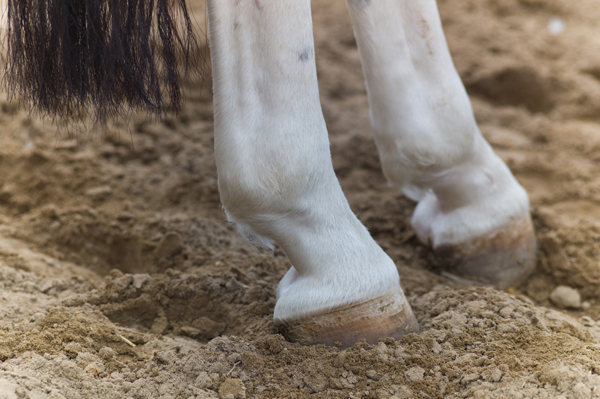Managing Laminitis in Horses: Sand Bedding and Trimming
Standing on sand bedding typically provides immediate relief for horses suffering from laminitis-associated hoof pain, but prolonged access to sand bedding as a comfort strategy has not been investigated until recently. Researchers explored the use of sand bedding in two horses with bilateral chronic laminitis.*
Why sand? Although the hoof wall acts as the primary weight-bearing surface of a well-trimmed hoof on a flat surface, weight distribution varies depending on ground surface and hoof characteristics, including wear and trim patterns. With this in mind, a portion of the horse’s weight may be placed on the frog and sole, and cause the laminitic horse pain. Because sand readily conforms to the shape of the hoof, weight is more broadly distributed across the ground surface.+
In the aforementioned study, researchers described the horses, both Thoroughbred stallions, as overweight on initial evaluation, though no body condition scores were mentioned. They assigned the horses a score on the Obel scale, which classifies clinical signs of laminitis-related pain into four categories. Researchers gave both stallions a grade III classification, meaning the horses were reluctant to move and resisted attempts to lift the affected or contralateral limb.
Application of hoof testers revealed sensitivity in all of the fore hooves. Radiographs confirmed severe rotation of the distal phalanx, or coffin, bone in all affected hooves. A farrier fitted both horses with conventional bars shoes without toe support in an effort to relieve toe pressure, but lameness intensified in all hooves, and the shoes were removed.
The two horses were then moved to individual paddocks where natural sand was used as footing. Each horse had access to a stall attached to the paddock and bedded with sand at a depth of about six inches (15 cm). Horses were fed a diet that consisted primarily of pangola hay with a small amount of concentrate daily. No pain-relieving medications or surgeries were provided during the confinement period. Radiographs were taken monthly, and trimming resumed 12 weeks following the beginning of sand-bedding confinement.
Researchers observed increased sole thickness following eight weeks of confinement and identified a decrease in the angle of the distal phalanx at 20 weeks. They summarized their findings by suggesting “long-term housing in sand-bedding confinement for at least 20 weeks corrected phalangeal rotation and improved hoof conformation in two stallions with bilateral chronic laminitis.”
To address the small sample size, one obvious limitation of the study, the researchers conceded that “the use of sand-bedding housing to manage chronic laminitis requires validation with a larger sample size.”
“As with all horses given access to sand or sandy soil, precautions should be taken to avoid ingestion of sand, such as feeding off the ground or feeding off of clean rubber mats,” explained Catherine Whitehouse, M.S., a nutrition advisor with Kentucky Equine Research. “A psyllium supplement may help prevent sand accumulation in the gastrointestinal tract. Providing an appropriate amount of psyllium to aid in sand removal is important, and recommendations often indicate 0.5-1 g/kg body weight.”
Another potential downside to using sand bedding is the difficulty in cleaning it; urine accumulates in the deeper layers, and both urine and manure must be removed often.+
In this study, both of the stallions were considered overweight and received no regular exercise, possibly predisposing them to endocrinopathic laminitis. “While there are no failsafe ways to avoid laminitis, thoughtful management considerations may help ward off the disease,” Whitehouse said. These include:
- Maintaining horses at a moderate body weight, usually a 5 on the familiar 1-9 body condition score card. “As susceptible horses creep into the 6 or 7 range, they may begin to experience problems,” she said, “so it’s important to carefully track body condition every week or so to ensure consistent condition.” For those that use the 0-5 body condition scale, maintaining horses at a score of 3 (moderate) is ideal, and horses in the 4-5 range (fat or very fat) may be more predisposed to obesity-related issues.
- Offering a primarily forage-based diet in which about 1.5% of body weight in forage is fed daily. Partial or full restriction of pasture grazing may be necessary based on individual needs of horses, and this can be achieved through turnout on dry lot or grazing muzzle. “Some owners really have a difficult time implementing these measures because they love their horses and ponies, and feel they’re depriving them of nourishment. Use of a grazing muzzle or a dry lot should be thought of as preventive, even health-affirming, not as an act of deprivation,” Whitehouse explained.
- Feeding a balancer pellet or a high-quality vitamin and mineral supplement, which will provide nutrients often deficient in forages without adding unnecessary calories. “Too many owners overlook the importance of daily fortification of forage-only diets,” she said, “and in doing so create deficiencies in their horses’ diets.”
- Engaging the horse in daily or near-daily structured exercise, whether it’s driving, riding, or longeing, assuming there are no soundness issues.
A veterinarian should be called when there is any suspicion of laminitis. If laminitis is left untreated, the health of some horses can spiral downward quickly. Once stabilized, laminitic horses should be managed carefully with professional assistance, including advice from a veterinarian, a farrier competent in caring for laminitic hooves, and a nutritionist well versed in diet recommendations.
*Wattanapornpilom, T., P. Pornprasitroj, K. Thongsri, S. Iamprapai, P. Suan-Aoy, and M. Chanda. 2022. The use of confined housing in sand bedding and trimming to manage phalangeal rotation and hoof malconformation over a 20-week period in two laminitic stallion. Journal of Equine Veterinary Science 116:104062.
+Parks, A.H., O.K. Balch, and M.A. Collier. 1999. Treatment of acute laminitis: Supportive therapy. Veterinary Clinics of North America: Equine Practice 15:363-374.











